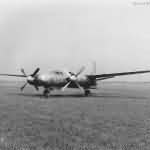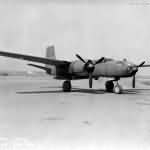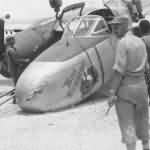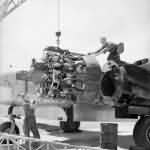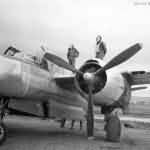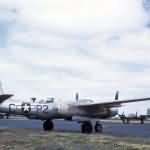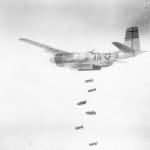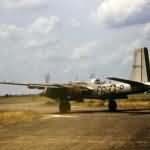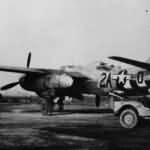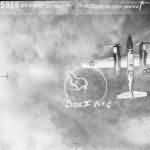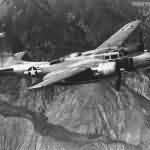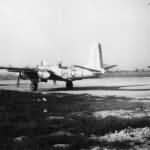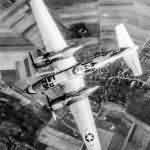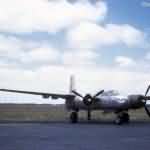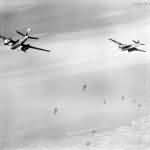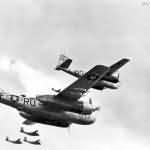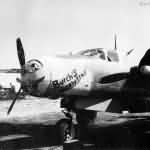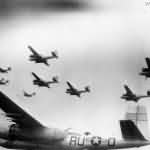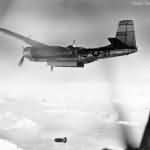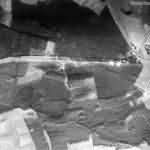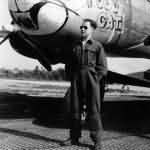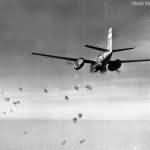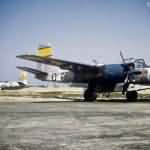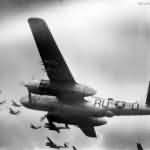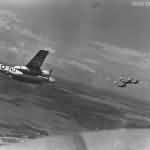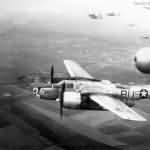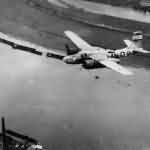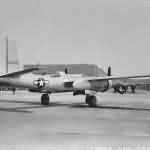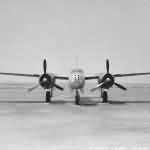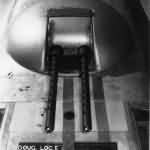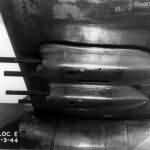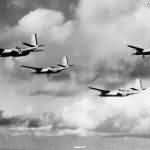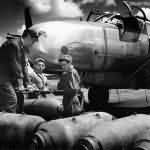XA-26 41-19504 during an early flight test
XA-26 41-19504 on the ground
Prototype with GE J31 turbojet installed in the rear fuselage and four-blade propellers
Night fighter prototype with four 20 mm cannon
XA-26A 41-19505
Prototype XA-26 41-19504
Invader I KL692 43-22604
Close-Up View of the nose of a A-26
Nose Armament A-26 Invader
USAAF Officers
Badly Damaged A-26C
Invaders in flight
T-13E1 75mm Gun
A-26 Invader Nose View
A-26 Miss Bird-Brain Okinawa 1945
A-26 Sarasota Base 1945
A-26 assembly
A-26 during Training Flight over AAF Tactical Center Orlando
A-26 engine
A-26 Invader 56th Combat Crew Training Wing
A-26 75mm cannon
670th Bomb Squadron 416th Bomb Group
Invaders of the 56th Combat Crew Training Wing
Bottom turret maintenance
A-26 44-34298 3rd BG 89thBS Okinawa
Invader 44-35544 47th Light Bombardment Group 1946
A-26 47th BG
A-26 47th Bomb Group
A-26 47th BG
A-26 47th BG
Invader 43-22653 391st Bomb Group at Nordholz March 1945
Invader used in special “Carpetbagger” operations over Germany. Harrington airfield
A-26 44-34216
A-26 43-22369 Stinky 386th Bomb Group
A-26 43-22439 Passing Over Leaning Tower Pisa
A-26 43-22575 47th Bomb Group
Bomber crashed at Asch Airfield (Y-29) Genk, Belgium 7 May 1945
A-26 43-22369 386th BG
A-26 43-22369 386th BG
A-26 43-22359 409th Bomb Group, mission to Dulmen 21 March 1945
A-26 43-22341 386th BG St Trond
A-26 43-22330 F6-P 416
A-26C 416th Bombardment Group
Invader drop 500 pounds bombs on target in Germany
A-26 43-22330
A-26 416th Bomb Group
A-26 416th Bomb Group
Invader had D-Day stripes applied to the underside of its rear fuselage
A-26 416th BG
A-26 416th BG
A-26 416th BG
A-26 41-39136
A-26 41-39298 386th Bomb Group Beaumont airfield
A-26 416th BG
A-26 409th Bomb Group Germany 1945
409th Bomb Group ‘Salutes’
A-26 409th Bomb Group, 640th BS (W5-?)
A-26 391st Bomb Group at Nordholz
A-26 391st Bomb Group
Bombers of 386th BG the taxi out at St Trond at the start of a squadron-strength operation in 1945
Flak bursts in the background
A-26 386th BG cockpit
A-26 386th Bomb Group
A-26 386th BG
A-26 386th BG
A-26 386th BG 6
A-26B 386th BG
Invader RU-O
A-26 386th BG
A-26 386th BG
A-26 386th BG
A-26 386th BG with shark mouth
A-26 386th BG
A-26 386th BG bomb run
A-26 386th BG over Belgium April 1945
A-26 386th BG
A-26 386th BG, 554th Bomb Squadron
A-26 386th BG
A-26 386th BG
A-26 386th BG
A-26 386th BG
A-26 386th BG
A-26 386th BG 27
A-26 386th BG
A-26 386th BG
A-26 386th BG
A-26 386th BG
A-26 386th BG
A-26 386th BG
A-26 386th BG
A-26 386th BG
A-26C 386th BG at St Trond
A-26 386th BG 18
A-26 386th BG
A-26 386th BG
A-26 386th BG
A-26 386th BG
A-26 386th BG
A-26 386th BG
A-26 386th BG 10
A-26 386th BG
A-26 386th BG
A-26 386th BG
A-26D 44-34100
A-26D 44-34100
A-26 319th Bomb Group
A-26D 44-34100
A-26D 44-34100
A-26C 9th AF
A-26C 44-35289
A-26B upper turret
A-26B underwing gun pods
Test installation of the 75mm cannon
A-26B HELLS BELLE
A-26B Invader 2
A-26B Invader 3rd BG 44-34233
A-26B 75mm 1944
A-26B 75mm
A-26B 48th Sqn, 41st Bombardment Group Okinawa
A-26B 47th BG Grosetto Italy
A-26B 41-39355
A-26B 41-39555
A-26B 41-39555
A-26B 416th BG over Germany
A-26B 44-34218
A-26B 44-34510
A-26B
A-26B 2
A-26B 386th BG over Germany
1st production Invader Long Beach
A-26B 41-39133 factory
A-26B 41-39136
A-26B 41-39198 of the of the 386th BG, 553rd BS
500lb Pound Bombs Loaded on Invader
Invader of the 56th Combat Crew Training Wing
The Invader corresponds to a 1940 USAAF specification for a light bomber capable of both precision low-level strafing and medium-level bombing. In order to be able to defend itself without an escort fighter, the A-26 must be both well armed and fast. The aircraft was designed by the design team of Edward H. Heinemann. . It is based on the layout of the A-20 Havoc, its predecessor. The prototype XA-26 was flown on 10.07.1942
While only a prototype of the XA-26A fighter version was built, the bomber and attack versions were produced in large numbers at the Douglas Company’s plants in Long Beach, California, and Tulsa, Oklahoma. The A-26B version had an enclosed nose, housing 6 or 8 fixed 12.7 mm machine guns, remote-controlled turrets on the dorsal and belly, each housing twol 12.7 mm MG. Well-armored and capable of carrying up to 1,814 kg of bombs, the A-26B, with a top speed of 571 km/h at an altitude of 4,570 m, was the fastest Allied bomber in World War II. A total of 1,355 examples of this version were built, including 1,150 at the Long Bcach plant (A-26B-1-DL to A-26B-66-DL series) and 205 at Tulsa (A-26B-5-DT to A-26B-25-DT series). A further 24 copies were built at the Long Beach plant, but were not delivered to the USAAF, some of which were later sold to other civilian customers. In 1948, the A-26B was renamed the B-26B; for this reason it is often confused with the Martin B-26 Marauder. The XA-26B prototype was also developed, armed with a fixed 75 mm cannon mounted in the nose of the fuselage. Some B-26B aircraft were converted into unarmed TB-26B training aircraft or unarmed VB-26B VIP transport aircraft.
A total of 1091 aircraft were built in the A-26C version with a glass nose for the bombardier. Of which 5 were built at the Long Beach plant (A-26C-1-DL and A-26C-2-DL series) and 1086 at the Tulsa plant (A-26C-16-DT to A-26B-55-DT series). A further 53 examples built at Tulsa were not delivered to the USAAF, some of which were later sold to other civilian or military customers. In 1948, the A-26C aircraft was renamed the B-26C. Some B-26C aircraft were converted to RB-26C reconnaissance aircraft, CB-26C transport aircraft, and TB-26C unarmed training aircraft.
At the end of World War II, prototype development versions were built:
– XA-26D- with an enclosed nose with 8 fixed 12.7 mm calibre nkm, further 6 12.7 mm calibre nkm were mounted in the wings. Pratt & Whitney R-2800-83 “Double Wasp” engines with 1544 kW (2100 hp) each. The order for 750 copies of the A-26D was cancelled after the war ended,
– XA-26E- similar to the XA-26D, but with a glass nose for the bombardier. The order for 2150 copies A-26E was cancelled after the war ended.
In the postwar period, a prototype XA-26F was built with a mixed powerplant consisting of two Pratt & Whitney R-2800-83 engines and an additional General Electric J31 jet engine. The aircraft received new Hamilton Standard type four-blade propellers. The prototype reached a maximum speed of 700 km/h. However, the installation of the jet engine, which significantly reduced the range, did not find practical use.
In September 1944, aircraft entered combat operating from the United Kingdom. Later they also operated from airfields in France and Italy. Many combat missions against the Germans were carried out, although not all the shortcomings of the aircraft were removed. The pilots were delighted with its maneuverability and ease of flying. With time, the defects were removed, and the Invader pilots began to take pride in flying such a demanding and effective bomber/attack aircraft. In the ETO, the A-26 flew 11,567 combat sorties and dropped 18,054 tons of bombs. Bomber was also maneuverable enough to handle itself, even when intercepted by fighters. On February 19, 1945, Major Myron L. Durkee of the 386th Bomb Group scored a probable shoot-down of a jet fighter Me 262 Schwalbe. Invaders also had seven confirmed air combat victories to their credit. Also during the fights with Japan in the Pacific the aircraft showed its advantages. Developing speed at sea level not less than 600 km/h, A-26 were a powerful weapon against ships and suitable for attacking ground targets. They replaced the Douglas A-20 and North American B-25 Mitchell bombers in combat units. The A-26s served with the 341st and 319th Bomb Groups of the USAAF during the battles in Formosa, Okinawa, and Japan itself.
General Specifications
- Type: Shoulder-wing cantilever monoplane.
- Wings: The aircraft has a laminar-flow wing section with no center-section; the left and right wing panels attach directly to the fuselage. The structure includes two spars built with unspliced spar caps and integral end fittings. The wings have chordwise stiffeners and flush-riveted metal skin. It features electrically-operated slotted trailing-edge flaps.
Fuselage
- Structure: All-metal semi-monocoque with a practically square cross-section featuring rounded corners.
Tail Unit
- Configuration: Cantilever monoplane type with a dihedral tailplane. It is an all-metal structure with trim-tabs in all control surfaces.
Landing Gear
- Configuration: Retractable tricycle type operated hydraulically. The main wheels retract into the engine nacelles, and the nose wheel rotates 90° to lie flat at the bottom of the fuselage.
Power Plant
- Engines: The aircraft is powered by two Pratt & Whitney R-2800-71 eighteen-cylinder radial air-cooled engines, each producing 2,000 horsepower with two-speed superchargers.
- Propellers: Equipped with three-blade Hamilton-Standard Hydromatic constant-speed quick-feathering airscrews.
- Engine Mountings: These are interchangeable between left and right positions. The mountings feature a large metal spinning forward, a stainless steel rear part, and six identical forgings connecting them. The engines have quick-release fittings for lines, pipes, and wiring, and cowling is split into two quickly removable halves. An access door in the firewall allows mechanics to work on the engine accessory section from within the nacelle. Fuel and oil tanks are located in the wings and nacelles, respectively.
Accommodation
- Crew: The aircraft accommodates a crew of three, with all positions armored.
Armament
- Nose Configurations: Various fuselage nose types allow for different armament installations, including a transparent bombardier nose.
- A-26B Armament: Fixed forward-firing armament of six .50 caliber machine guns in the nose, with provisions for up to eight additional .50 caliber “package” guns under the wings, mounted in pairs outside each engine nacelle.
- A-26C Armament: Features a transparent bombardier nose and two fixed .50 caliber guns. Defensive armament includes two twin .50 caliber machine gun turrets, one above and one below the fuselage. These turrets are remotely controlled from a gun-sighting station aft of the wings, with aiming via periscopic sights. The upper turret, when locked in the forward position, can be fired by the pilot along with the nose armament.
- Bomb Bays: Internal bomb bays with hydraulically-operated doors, and external bomb racks under the wings.
Dimensions
- Span: 70 ft. (21.35 m)
- Length: 50 ft. 9 in. (15.47 m)
- Height: 18 ft. 6 in. (5.64 m)
- Wing Area: 540 sq. ft. (50 sq. m)


